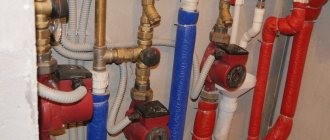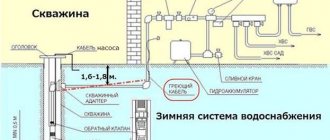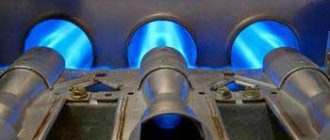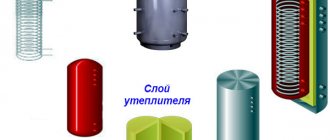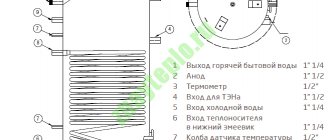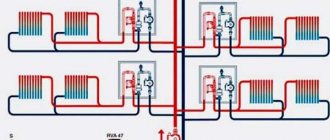A new column has appeared in receipts for utility services - hot water supply. It caused confusion among users, since not everyone understands what it is and why it is necessary to make payments on this line. There are also apartment owners who cross out the box. This entails the accumulation of debt, penalties, fines and even litigation. In order not to take matters to extreme measures, you need to know what DHW is, DHW heat energy and why you need to pay for these indicators.
What is DHW on the receipt?
DHW - this designation stands for hot water supply. Its goal is to provide apartments in apartment buildings and other residential premises with hot water at an acceptable temperature, but hot water supply is not the hot water itself, but the thermal energy that is spent on heating the water to an acceptable temperature.
Experts divide hot water supply systems into two types:
- Central system. Here the water is heated at a heating station. After this, it is distributed to apartments in multi-apartment buildings.
- Autonomous system. It is usually used in private homes. The principle of operation is the same as in the central system, but here the water is heated in a boiler or boiler and is used only for the needs of one specific room.
Both systems have the same goal - to provide home owners with hot water. In apartment buildings, a central system is usually used, but many users install a boiler in case the hot water is turned off, as has happened more than once in practice. An autonomous system is installed where it is not possible to connect to the central water supply. Only those consumers who use the central heating system pay for hot water supply. Users of an autonomous circuit pay for utility resources that are spent to heat the coolant - gas or electricity.
Important! Another column in the receipt related to DHW is DHW at one unit. Decoding ODN - general house needs. This means that the DHW column on one unit is the expenditure of energy on heating water used for the general needs of all residents of an apartment building.
These include:
- technical work that is performed before the heating season;
- pressure testing of the heating system carried out after repair;
- repair work;
- heating of common areas.
Hot water law
The law on hot water supply was adopted in 2013. Government Decree No. 406 states that users of a central heating system are required to pay a two-part tariff. This suggests that the tariff was divided into two elements:
- thermal energy;
- cold water.
This is how DHW appeared on the receipt, that is, the thermal energy spent on heating cold water. Housing and communal services specialists came to the conclusion that risers and heated towel rails, which are connected to the hot water supply circuit, consume thermal energy to heat non-residential premises. Until 2013, this energy was not taken into account in receipts, and consumers used it free of charge for decades, since the air in the bathroom continued to be heated outside the heating season. Based on this, officials divided the tariff into two components, and now citizens have to pay for hot water.
What is it and what does it look like on the receipt?
DHW (Heating) refers to the total cost of energy spent heating cold water. Hot water in apartment buildings is paid for by residents according to the meter or individual coefficient .
Additionally, the tariff per cubic meter is taken into account, which is set according to the standards of the region where the citizen lives. To find the hot water supply item in the receipt for payment of housing and communal services, you need to look at the “Type of payment” column. In the subsection “Maintenance of common property” there will be a line “DHW. Heating”, which provides information on the tariff, energy consumption rate, SOI coefficient and SME.
Technological process:
- Cold water is supplied to an apartment building.
- With the help of a boiler, heating occurs to the set temperature.
- The water is then supplied to the residents of the house.
Water heating equipment
The equipment that heats the liquid is a water heater. Its breakdown does not affect the hot water tariff, but users are required to pay the cost of repairing the equipment, since water heaters are part of the property of homeowners in an apartment building. The corresponding amount will appear in the receipt for the maintenance and repair of the property.
Important! This payment should be carefully considered by the owners of those apartments that do not use hot water, since their housing has an autonomous heating system installed. Housing and communal services specialists do not always pay attention to this, simply distributing the amount for water heater repairs among all citizens.
As a result, these apartment owners have to pay for equipment they did not use. If you discover an increase in the tariff for repairs and maintenance of property, you need to find out what this is connected with and contact the management company for recalculation if the payment was calculated incorrectly.
Equipment
If your water heater fails, your hot water bill will not increase. In this case, authorized employees of the management organization are required to repair the equipment urgently. But since repairs require payment, residents must still pay this amount. Although the heating bill will remain the same, the cost of repairs and maintenance of the property will increase. This is explained by the fact that water heating devices are part of the property of homeowners.
As for non-standard situations, when, for example, some apartments in a multi-storey building have access to hot water, and the second only to cold water, issues regarding payment for heating are resolved on an individual basis. As practice shows, residents are often required to pay for common property that they do not use.
Thermal energy component
What is this - a coolant component? This is heating cold water. The thermal energy component does not have a meter installed, unlike hot water. For this reason, it is impossible to calculate this indicator using a counter. How, in this case, is the thermal energy for hot water calculated? When calculating the payment, the following points are taken into account:
- tariff set for hot water supply;
- expenses spent on maintaining the system;
- cost of heat loss in the circuit;
- costs spent on coolant transfer.
Important! The cost of hot water is calculated taking into account the volume of water consumed, which is measured in 1 cubic meter.
The size of the energy fee is usually calculated based on the readings of the common hot water meter and the amount of energy in the hot water. Energy is also calculated for each individual apartment. To do this, water consumption data is taken, which is learned from the meter readings, and multiplied by the specific heat energy consumption. The received data is multiplied by the tariff. This figure is the required contribution, which is indicated on the receipt.
How to calculate it yourself in 2018-2019
Water heating is one of the most expensive utilities. This is explained by the fact that when heating it is necessary to use special equipment operating from the mains. To make sure that the receipt shows the correct amount to be paid, you can do the calculations yourself and compare the resulting value with the amount indicated on the receipt. To do this, you need to find out the amount of payment for thermal energy established by the regional tariff commission. Further calculations depend on the presence or absence of metering devices:
- If you have a meter installed in your apartment, then you can calculate the consumption of thermal energy based on its indicator.
- If there is no meter, calculations should be made based on established standard indicators (set by an energy-saving organization).
If there is a general heat energy consumption meter in a residential building and individual meters installed in the apartments, the calculation of the amount for heating is calculated based on the readings of the general meter and further proportional distribution for each apartment. If such a device is not available, the amount required to pay for heating is calculated based on the standard energy consumption for heating 1 m 3 of water in the reporting month and the readings of an individual water meter.
How to make your own calculation
Not all users trust the payment center, which is why the question arises of how to calculate the cost of hot water supply yourself. The resulting figure is compared with the amount on the receipt and on the basis of this a conclusion is made about the correctness of the charges.
To calculate the cost of hot water supply, you need to know the tariff for thermal energy. The amount is also affected by the presence or absence of a meter. If there is one, then readings are taken from the meter. In the absence of a meter, the standard for the consumption of thermal energy used to heat water is taken. This standard indicator is established by an energy saving organization.
If an energy consumption meter is installed in a multi-storey building and the housing has a hot water meter, then the amount for hot water supply is calculated based on general building metering data and the subsequent proportional distribution of the coolant among apartments. If there is no meter, the rate of energy consumption per 1 cubic meter of water and the readings of individual meters are taken.
How is the charge for hot water supply calculated? What is DHW heating
Charging for hot water supply consists of two parts, or components, each of which is highlighted in a separate line on the receipt - DHW and DHW heating. This is due to the fact that in Academichesky houses, water preparation is carried out directly by the management company in individual heating points of each house. In the process of preparing hot water, two types of utility resources are used - cold water and thermal energy.
The first component, the so-called DHW supply
- this is directly the volume of water that passed through the hot water supply meter and was consumed indoors in a month. Or, if the readings were not taken, or the meter turned out to be faulty or its verification period has passed, the volume of water determined by calculation according to the average or standard for the quantity prescribed. The procedure for calculating the volume of hot water supply is exactly the same as for cold water supply. To calculate the cost of this service, the tariff for cold water is applied, since in this case it is cold water that is purchased from the supplier.
Second component, DHW heating
- this is the amount of thermal energy that was expended to heat the volume of cold water provided to the apartment to hot temperature. This amount is determined based on the readings of the common house heat energy meter.
In general, the fee for hot water supply is calculated using the following formula:
Pigv = Vpgvi × T xv + q v cr × Vpgvi × T v cr
Where:
Vpgvi - the volume of hot water consumed during the billing period (month) in an apartment or non-residential premises
Tхв - tariff for cold water
qvкр - specific consumption of thermal energy for heating water
Vpgvi - the total volume of hot water consumed during the billing period in all rooms of the house
Tvкр - tariff for thermal energy
The specific consumption of thermal energy for heating water is determined by formula 20.1 of the Russian Federation Regulations dated December 26, 2016. No. 1498
q v cr
= V cr / (Q gv + Q from ) × Ntagvs
where:
Vcr - volume of thermal energy according to a common house meter
Qgv + Qot - the amount of thermal energy spent on heating and water heating in all rooms of the house and for general house needs Ntegvs - the standard for the consumption of thermal energy used for heating DHW
For Academichesky houses, taking into account their engineering and design features, the value of qvcr is equal to the standard for thermal energy consumption, and is:
- for houses with water heated towel rails: 0,05131
Gcal/m2
- for houses with electric heated towel rails: 0,04912
Gcal/m2
Complaint due to incorrect calculation of receipt
If, after independently calculating the amount of contributions for hot water supply, a difference is identified, you must contact the management company for clarification. If the organization's employees refuse to provide explanations on this matter, a written complaint must be submitted. Company employees have no right to ignore it. The response must be received within 13 working days.
Important! If no response is received or it is not clear from it why this situation arose, then the citizen has the right to file a claim with the prosecutor’s office or a statement of claim in court. The authority will consider the case and make an appropriate objective decision. You can also contact organizations that control the activities of the management company. Here the subscriber's complaint will be considered and an appropriate decision will be made.
Electricity used to heat water is not a free service. Payment for it is charged on the basis of the Housing Code of the Russian Federation. Each citizen can independently calculate the amount of this payment and compare the data obtained with the amount on the receipt. If any inaccuracy occurs, you should contact the management company. In this case, the difference will be compensated if the error is recognized.
